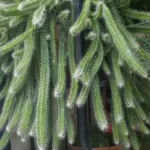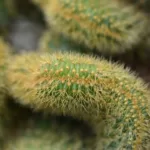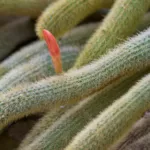If you’re a plant lover looking for a unique, easy-to-care-for cactus, Here’s our complete Dog Tail Cactus Care Guide! For you.
As a plant lover, I’m always on the lookout for unique and interesting plants to add to my collection. One day, while browsing through a local nursery, a small cactus caught my eye. It had long, slender stems that resembled a dog’s tail, and I couldn’t resist bringing it home.

Little did I know, that Dog Tail Cactus would become one of my favorite plants to care for. In this article, I will share my complete guide on how to care for this fascinating plant, so you too can experience the joy of owning a Dog Tail Cactus.
This desert plant is known for its unique appearance, with long, curly tails that resemble a dog’s wagging tail. In this guide, we’ll provide you with everything you need to know to care for your Dog Tail Cactus and keep it healthy and thriving.
Overview of the Dog Tail Cactus

The Dog Tail Cactus, also known as Aporocactus flagelliformis or Rat Tail Cactus, is native to Mexico and Central America. It’s a trailing cactus that can grow up to six feet long in its natural habitat, but when grown indoors, it usually stays much smaller, around two to three feet in length.
Different names for Dogtail Cactus
The Dog Tail Cactus, also known as the Rat Tail Cactus or Aporocactus Flagelliformis, is a member of the Cactaceae family. It’s native to Central and South America and is widely grown as an ornamental plant in many parts of the world. Besides its common name, it’s also known by several other names, including:
- Rat Tail Cactus: This name comes from the cactus’s long, thin stems that resemble a rat’s tail.
- Whip Cactus: The Dog Tail Cactus is sometimes referred to as the Whip Cactus because of its thin, flexible stems that can be trained to grow in various shapes and directions.
- Rattail Aporocactus: This name is simply a combination of the cactus’s two most common names – Rat Tail and Aporocactus.
- Mistletoe Cactus: The Dog Tail Cactus is sometimes called the Mistletoe Cactus because of its bright red or pink flowers that bloom around Christmas time.
Regardless of what you call it, the Dog Tail Cactus is a unique and charming addition to any plant collection.
Dog Tail Cactus Appearance

The Dog Tail Cactus has slender, trailing stems that grow up to ¼ inch in diameter. Its stems have tiny spines that are not harmful to humans or pets. The cactus produces pink, red, or white flowers that bloom in the spring and summer months.
Is Dog Tail Cactus rare?
The Dog Tail Cactus is not considered a rare plant. It’s a popular ornamental plant that’s widely cultivated and sold in nurseries and garden centers around the world.
However, like all plants, the availability of the Dog Tail Cactus may vary depending on the region and time of year. Some rare or unusual cultivars of the cactus may also be harder to find and may be more expensive than the standard variety.
Overall, the Dog Tail Cactus is a relatively easy-to-find plant that can add a touch of whimsy and charm to any home. With its unique shape and low-maintenance care, it’s a popular choice among plant lovers and cactus enthusiasts alike.
Is Dog Tail Cactus toxic?

The Dog Tail Cactus, or Rat Tail Cactus, is not considered toxic to humans or pets. In fact, it’s a safe plant to have around pets and children, as it doesn’t have any spines or thorns that could cause injury.
However, like all cacti, the Dog Tail Cactus does have small, hair-like structures called glochids that can be irritating if they come in contact with the skin. These glochids can easily become embedded in the skin and may cause redness, itching, or a rash.
To avoid coming into contact with the glochids, it’s recommended to wear gloves when handling the cactus or use a pair of tongs to move it. If you do happen to get glochids in your skin, carefully remove them with a pair of tweezers and wash the area thoroughly with soap and water.
You can also read How Harmful is Pothos for Pets?
The Dog Tail Cactus Care
Dog Tail Cactus Lighting Requirements
The Dog Tail Cactus requires bright or full sun and indirect light. It can tolerate some direct sunlight. If you’re growing your cactus indoors, place it near a south or west-facing window where it can get plenty of sunlight. Insufficient sunlight can cause the stems of the Dog Tail Cactus to appear thin, pale, or weak.
Can you keep Dog Tail Cactus outdoors?
The Dog Tail Cactus can be kept outdoors in areas that have a warm, dry climate with plenty of sunlight. It’s important to ensure that the cactus is not exposed to freezing temperatures, as it’s not frost-tolerant.
Dog Tail Cactus Temperature and Humidity
The Dog Tail Cactus prefers warm temperatures between 70-90°F during the day and 50-70°F at night. It can tolerate lower temperatures for short periods, but prolonged exposure to cold temperatures can damage the plant.
The cactus is also adaptable to low humidity levels, making it a great option for those living in dry environments.
Dog Tail Cactus Watering Requirements
Like most cacti, the Dog Tail Cactus is drought-tolerant and can go for long periods without water. Water your cactus when the soil is completely dry, usually every two to three weeks during the growing season, and every four to six weeks during the winter.
Be sure to avoid overwatering, as this can lead to root rot and other issues. Always check the soil moisture level before watering and adjust as needed.
Dog Tail Cactus Soil and Fertilizer
The Dog Tail Cactus prefers well-draining soil that’s rich in organic matter. A mix of cactus soil and perlite or sand works well. When repotting your cactus, choose a pot that’s slightly larger than the current one, and make sure it has drainage holes.
Fertilize your cactus once a month during the growing season, using a balanced, water-soluble fertilizer diluted to half strength.
How to propagate Dog tail Cactus

The Dog Tail Cactus can be propagated by stem cuttings. Simply cut a 3-4 inch stem section and let it callus over for a few days or for at least 24 hours. Then, plant it in well-draining soil and keep it in a warm, bright location until it roots.
Dog Tail Cactus Common Problems
The most common issues with the Dog Tail Cactus are overwatering and inadequate lighting. Signs of overwatering include yellowing leaves, mushy stems, and a rotten smell. If you notice these signs, stop watering immediately and let the soil dry out.
Inadequate lighting can cause the cactus to become leggy and pale in color. Move it to a brighter location and reduce watering until it recovers.
Final Thoughts
The Dog Tail Cactus is a unique, low-maintenance plant that’s perfect for beginners and experienced plant owners alike. With proper care, it can live for many years and provide a beautiful, desert-inspired touch to your home.
In conclusion, the Dog Tail Cactus is an easy-to-care-for plant that adds a unique touch to any home. With the right conditions, it can thrive for years and bring joy to its owner. Remember to give it bright, indirect light, well-draining soil, and careful watering. Happy plant parenting!
FAQs
Is the Dog Tail Cactus toxic to pets?

No, the Dog Tail Cactus is not toxic to pets or humans. However, it’s still best to keep it out of reach of pets to prevent accidental ingestion.
How often should I fertilize my Dog Tail Cactus?

Fertilize your cactus once a month during the growing season, which is typically from spring to early fall. You can use a balanced, water-soluble fertilizer that’s diluted to half strength.
Can I grow my Dog Tail Cactus outdoors?

If you live in a warm climate with well-draining soil, you can grow your Dog Tail Cactus outdoors. Just be sure to place it in a location that gets bright, indirect sunlight and protects it from freezing temperatures.
What should I do if my Dog Tail Cactus starts to rot?

If you notice your cactus starting to rot, stop watering immediately and let the soil dry out completely. Cut away any affected stems and replant the healthy parts in fresh, well-draining soil.
How long can a Dog Tail Cactus live?

With proper care, a Dog Tail Cactus can live for many years, up to 20-30 years or more. However, its lifespan can vary depending on various factors such as lighting, temperature, and watering conditions.

